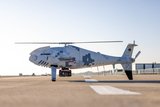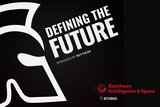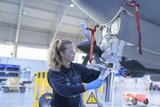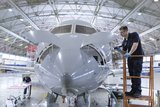Unlocking the future battlespace with multi-intelligence (Studio)
Ambitious new programmes such as South Korea’s new ISTAR project must interpret the operating environment in all of its complexity.
For Raytheon, that comes down to one core concept: the multi-intelligence (Multi-INT) approach.
The Republic of Korea Air Force (ROKAF) requires up to four ISTAR aircraft by the end of 2022, with a range of missions in mind: most obviously, monitoring the activity of their neighbours to the north, but also helping with disaster relief, directing humanitarian aid, and more.
Raytheon has partnered with Korean Air for its pitch, with the companies working with Bombardier to modify Global 6500 business jets.
Raytheon would serve as prime contractor, installing a comprehensive sensor package that includes a synthetic aperture radar and a ground moving target indicator radar, along with a multifunction electro-optical/infrared (EO/IR) sensor and signals intelligence (SIGINT) suite.
There is also a significant ground element to the programme, with operators in the aircraft able to stream data to a ground station, which could then be rerouted to other platforms, such as UAVs.
The combination of such sensors is key to forming a comprehensive picture of the modern battlefield, said Richard Sandifer, Raytheon’s Korea ISTAR capture executive.
Militaries are now faced with a chaotic, complex, and crowded scenario. While a single-sensor solution – such as a radar on an aircraft – can sometimes create more problems than it solves, restricting operators to a narrow perspective, a Multi-INT approach exploits the combination of various different data sources, from radar to EO/IR.
‘We process all that data in near-real time and deliver an easy to understand, concise and highly accurate picture of what the adversary is doing,’ Sandifer said, noting that a common operating picture supports commanders in the air and on the ground to make swift, accurate decisions.
Raytheon’s ISTAR technology ranges from airborne platforms to onboard systems in many different combinations. It can support operators in a number of roles, such as tracking mobile ground targets, mapping natural disasters, monitoring littoral and border areas, and overseeing vessels in support of maritime embargoes, to name just a few.
The South Korean opportunity is titled the joint mobile target monitoring and control Joint Moving Target Surveillance Command Aircraft Programme.
Raytheon believes its partnership with Korean Air will bring key advantages, Sandifer said, with the South Korean company providing design, logistics and lifecycle support services and modifying the aircraft for special mission functions.
Korean Air has a long history in this market. The company is the largest military aircraft upgrade and maintenance company in Asia-Pacific, conducting such support for more than 4,500 aircraft, including Korean and US fighters, cargo aircraft and helicopters. It also has a significant background in unmanned aerial vehicles (UAVs), an increasingly vital domain.
Raytheon hopes to leverage its international workload in its bid. For example, its UK projects have been a key driver of the company’s growth in the wider airborne intelligence, surveillance and reconnaissance (ISR) space.
Raytheon was the first company to deploy an international ISTAR-type aircraft; these have been operated by the Royal Air Force since 2008.
Likewise, the Shadow R1 tactical C-ISTAR solution supports UK and international operations. Raytheon continues to build on this platform’s capabilities, through a specialised enhancement programme and by providing in-service support.
An ISTAR capability will enable South Korea to enjoy the many advantages of Multi-INT, Sandifer said, providing a tactical advantage that simply wouldn’t otherwise exist, notably through the combination of SIGINT and radar.
‘We meld and merge those two capabilities … to give us a straight stream, so that the [operator] can look down and see exactly from either the radar or the SIGINT or the combination, and track the target,’ Sandifer said. ‘So, you're basically blending the radar and the SIGINT to get the whole picture.’
The advantages of Multi-Int ISTAR go beyond individual missions, serving as a force multiplier across the board. More broadly, the technology will support the Republic of Korea Armed Forces as they prepare to assume operational control from US forces in the coming years, Sandifer explained.
‘This is an incredibly important system for them to have that operational control, to have the interoperability with the US forces that are there, the allies that are there,’ he noted. ‘This system will be able to communicate with allies, with partners, and [integrate] battle management command and control … it'll be able to see the entire battlespace.’
Raytheon formally completed its merger with UTC in April, leading to the formation of Raytheon Technologies Corporation. The company is now divided into four sections: two Raytheon divisions that focus on military and space technologies, as well as the Pratt & Whitney and Collins Aerospace Systems divisions from the old UTC.
These different divisions play a key role in Raytheon and Korean Air’s pitch for the ROKAF contract, Sandifer said.
‘I think that has also strengthened our hand in-country,’ he argued. ‘Collins has a significant role on this aircraft. They actually do the Glass Cockpits for the 6500, which is very important.’
He said that South Korea is considering acquiring a long-range optical camera as part of the project, which Collins could provide.
‘I think it's a great opportunity for us as a company.’
Given the nature of its regional environment, South Korea has very particular requirements for its ISTAR capabilities. However, while he was unable to provide particular details at this stage, Sandifer noted the potential global demand for the Multi-INT approach.
‘The Korean requirements are probably the most stringent of all the requirements out there, because of the environment that they're in. They have to have … all of that capability to be able to do what they need, and that is to protect their people,’ he said.
‘We do have other potential customers, which I can't get into right now. But this is something that we will use time and time again, this type of [Multi-Int] platform.’
More from Defining the Future Special Report (Studio)
-
![Defining the Future Podcast Bonus Episode - the Multi-INT Approach]()
Defining the Future Podcast Bonus Episode - the Multi-INT Approach
How is the multi-intelligent approach bringing new capabilities to the modern battlefield?
-
![The Next Giant Leap Capability Profile (Studio)]()
The Next Giant Leap Capability Profile (Studio)
A thriving space sector will have long-term positives for the UK economy, fuelled by new initiatives by government and industry.
-
![Defining the Future Podcast Episode 2 - The Next Giant Leap]()
Defining the Future Podcast Episode 2 - The Next Giant Leap
What's the role of the UK space sector in the global Britain envisioned for the future?
-
![Training for the Future Capability Profile (Studio)]()
Training for the Future Capability Profile (Studio)
The world of work is changing, with COVID-19 and emerging technologies accelerating existing trends in defence and wider afield. Raytheon UK believes the training sector …
-
![Transforming training is crucial to future-proofing our armed forces]()
Transforming training is crucial to future-proofing our armed forces
Future-proofing our training is the best way of ensuring our Armed Forces are equipped to keep us safe and secure in the future says Frazer …
-
![Defining the Future Podcast Episode 1 - Training for the Future]()
Defining the Future Podcast Episode 1 - Training for the Future
Welcome to Shephard Studio’s Defining the Future podcast, sponsored by our partner Raytheon UK. Listen on Apple Podcasts, Google Podcasts, Spotify and more. The way we work is changing …


























